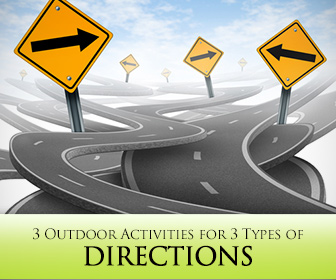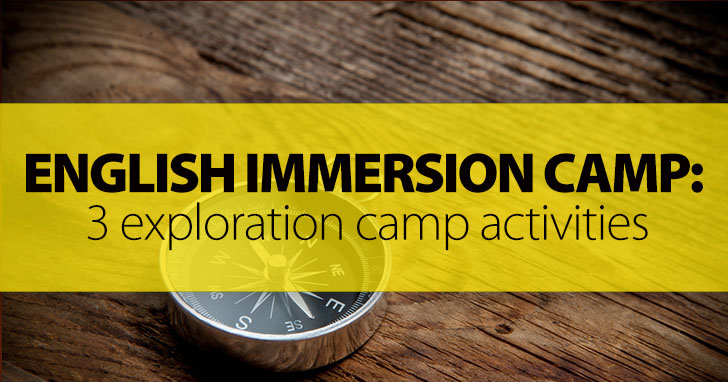3 Outdoor Activities for 3 Types of Directions


Part of this may be that most of us were fed a pretty regular diet of tales about early North American explorers and the various things they did, but a bigger part is the simple truth that kids just love adventure and daring and all the things that those entail. So, what if you could help them blaze their very own trail, create a map, and find the treasure? Think they might be interested? I know my students would be!
So, how do we go about doing that? Well, there are several approaches. For obvious reasons this is primarily a camp project. You need large, uninterrupted blocks of time and the focus is quite narrow. Ideally, the students will have already been exposed to directions-based dialogues and vocabulary, allowing the camp to build off a common starting point. If the students have not been exposed to directions material, this will likely have to be day one, lesson one. Even if they have, a little ten minute refresher of some design would not hurt. Be sure that you create a good context. Maybe show them the cartoon version of Treasure Island or some other treasure hunting or exploring movie to get them in the mood, then relate your camp to that. Either way, you can’t just toss your kids into the activities and expect them to be excited; they must fit within a larger camp framework and story.
A heads up before you dive too far into this process, it takes a lot of preparation on the teacher’s part, but it’s really worth it to see the kids enjoying themselves and using English to accomplish fun tasks.

This one is relatively flexible and can be adapted for various levels. Ideally, it takes the form of either a scavenger hunt (where they must follow a map to a set location where they receive the next small map to carry on with their quest) or a written set of directions that takes them to the final location at in a roundabout manner. Both of these ensure that they are not able to just cut corners and go straight to where ‘x marks the spot’. The first of the two is my favourite, but it takes more work on the teacher’s part. You must first create the course and identify the various checkpoints where students will receive the next section of their treasure map. If at all possible, have a teacher or some other English speaking volunteer there to ensure that the students are on track and that the next section of the map does not go missing. I prefer to have the different groups take different routes to arrive at the final destination. To do this you have use the same stopping points but change the order for each group. Obviously, teachers will have to create and cut up all the different treasure maps well before the beginning of the activity.
To increase the difficulty of this version, teachers can have a task/riddle/puzzle that students must complete at each station to get the next section of their map.
Once again, there are two possible versions of this activity. One is quite simple and involves the students creating a route along city streets with an assigned number of stops. This is a relatively common directions activity and pretty self-explanatory. The method I will discuss here is much more complex and, fair warning, works best if the teacher has a solid grasp of orienteering. It requires a relatively detailed map complete with a scale and compass lines, a compass, a ruler or some other measuring device that matches the scale, a large park (preferably with unmapped trails), and a measuring tape or marked-out 100 metre line.
To begin with, students must determine how much distance they cover with each step. To do this use the tape measure or marked out area to create a set distance in metres. Students then walk this distance counting their steps. When they cover the entire distance, they divide the distance by the number of steps to come up with how long their strides are. Be sure to tell the students that it is best to walk normally for this, as many will try and step as far as they can and this makes the measurement even less accurate.
Once this is done, show the students how to accurately use a map and compass. Rather than detail the methods here, I will leave it to the teachers to discover this for themselves; however, I will say that once you understand the basic principles, the rest follows pretty quickly. Have the students practice following a set of compass bearings across the soccer pitch or around the school to get them used to using the compass and map.
One they have grasped this, show them how it is possible to create a route on the map. You do this as a group. One person stands at the start point with the compass. The second person walks in a straight line, counting their steps. Once they reach the point where a turn is made they stop. The first person shoots a compass bearing from the start point to where the person has stopped. They then transfer that bearing to the map, student two calls out the distance covered and they draw a line from the start point, along that bearing for the given distance. This is then the first leg of the ‘trail’ being mapped. Of course, maps, compasses, and paces being what they are this is far from a perfect system, but it will certainly keep the students entertained and using direction based language as well as teaching them the difficulty of creating maps before computers.
These are very similar to the first activity, but all directions are given in riddles. Now, even though riddles can be adapted for various levels, this activity would likely be a bit difficult for lower level students. Once again, the teacher must create the initial route(s) and then go the extra mile of coming up with effective riddles or puzzles that give groups the next step in their journey. Complexity will have to vary by level, but it is a good idea to tie the riddles to concepts you have recently practiced with the students, or to things that they will already be very familiar with. Most likely this activity will be taking place in their own school/neighbourhood so there should be no shortage of common landmarks to use as references. It can be as simple or as complicated as the teacher wants to make it. An example clue would be ‘I am three colours and I help with traffic control. If you look around you will see me.’ This of course is a relatively simple clue for a traffic light. From there you could add references to oddly shaped buildings, common hangouts, or places that students love to hate. Really, you are only limited by your imagination and your students’ levels!
They can work well on their own, but they work best as part of a larger framework or story line. Teachers can create a theme camp based around the idea of searching for a buried treasure in an unexplored land with a map that is entirely riddles. They could then move on to creating a more accurate map (through the mapping activity) so that they can find their way back to the treasure at a later date. Having the activities strung together will help keep the kids interested and lessen the sense that they are just jumping from one topic to another. Best of luck with your explorations.